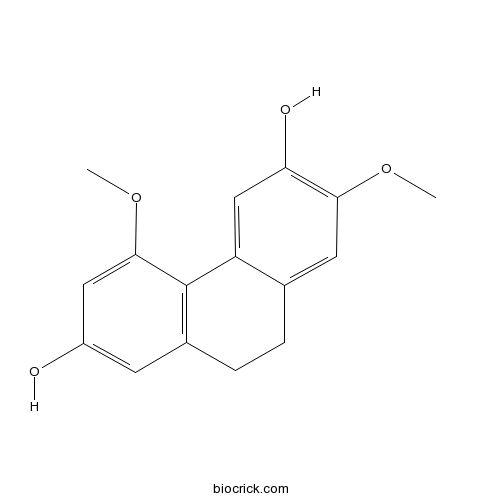CallosinCAS# 166197-43-9 |

Quality Control & MSDS
3D structure
Package In Stock
Number of papers citing our products

| Cas No. | 166197-43-9 | SDF | Download SDF |
| PubChem ID | 86182261 | Appearance | Powder |
| Formula | C16H16O4 | M.Wt | 272.29 |
| Type of Compound | Phenols | Storage | Desiccate at -20°C |
| Solubility | Soluble in Chloroform,Dichloromethane,Ethyl Acetate,DMSO,Acetone,etc. | ||
| Chemical Name | 4,7-dimethoxy-9,10-dihydrophenanthrene-2,6-diol | ||
| SMILES | COC1=CC(=CC2=C1C3=CC(=C(C=C3CC2)OC)O)O | ||
| Standard InChIKey | RQIIPCKHAHBFOT-UHFFFAOYSA-N | ||
| Standard InChI | InChI=1S/C16H16O4/c1-19-14-6-9-3-4-10-5-11(17)7-15(20-2)16(10)12(9)8-13(14)18/h5-8,17-18H,3-4H2,1-2H3 | ||
| General tips | For obtaining a higher solubility , please warm the tube at 37 ℃ and shake it in the ultrasonic bath for a while.Stock solution can be stored below -20℃ for several months. We recommend that you prepare and use the solution on the same day. However, if the test schedule requires, the stock solutions can be prepared in advance, and the stock solution must be sealed and stored below -20℃. In general, the stock solution can be kept for several months. Before use, we recommend that you leave the vial at room temperature for at least an hour before opening it. |
||
| About Packaging | 1. The packaging of the product may be reversed during transportation, cause the high purity compounds to adhere to the neck or cap of the vial.Take the vail out of its packaging and shake gently until the compounds fall to the bottom of the vial. 2. For liquid products, please centrifuge at 500xg to gather the liquid to the bottom of the vial. 3. Try to avoid loss or contamination during the experiment. |
||
| Shipping Condition | Packaging according to customer requirements(5mg, 10mg, 20mg and more). Ship via FedEx, DHL, UPS, EMS or other couriers with RT, or blue ice upon request. | ||

Callosin Dilution Calculator

Callosin Molarity Calculator
| 1 mg | 5 mg | 10 mg | 20 mg | 25 mg | |
| 1 mM | 3.6726 mL | 18.3628 mL | 36.7255 mL | 73.4511 mL | 91.8139 mL |
| 5 mM | 0.7345 mL | 3.6726 mL | 7.3451 mL | 14.6902 mL | 18.3628 mL |
| 10 mM | 0.3673 mL | 1.8363 mL | 3.6726 mL | 7.3451 mL | 9.1814 mL |
| 50 mM | 0.0735 mL | 0.3673 mL | 0.7345 mL | 1.469 mL | 1.8363 mL |
| 100 mM | 0.0367 mL | 0.1836 mL | 0.3673 mL | 0.7345 mL | 0.9181 mL |
| * Note: If you are in the process of experiment, it's necessary to make the dilution ratios of the samples. The dilution data above is only for reference. Normally, it's can get a better solubility within lower of Concentrations. | |||||

Calcutta University

University of Minnesota

University of Maryland School of Medicine

University of Illinois at Chicago

The Ohio State University

University of Zurich

Harvard University

Colorado State University

Auburn University

Yale University

Worcester Polytechnic Institute

Washington State University

Stanford University

University of Leipzig

Universidade da Beira Interior

The Institute of Cancer Research

Heidelberg University

University of Amsterdam

University of Auckland

TsingHua University

The University of Michigan

Miami University

DRURY University

Jilin University

Fudan University

Wuhan University

Sun Yat-sen University

Universite de Paris

Deemed University

Auckland University

The University of Tokyo

Korea University
- Phrymarolin V
Catalog No.:BCN9494
CAS No.:1449376-84-4
- 5-Hydroxy-3,6,7,4'-tetramethoxyflavone
Catalog No.:BCN9493
CAS No.:14787-34-9
- Chrysosplenol C
Catalog No.:BCN9492
CAS No.:23370-16-3
- 2,4,3',4',6'-Penta-O-(3-methylbutanoyl)sucrose
Catalog No.:BCN9491
CAS No.:150302-84-4
- (-)-Sesamin 2,2'-diol
Catalog No.:BCN9490
CAS No.:1152441-87-6
- Vesticarpan
Catalog No.:BCN9489
CAS No.:69853-46-9
- 24,24-Dimethyl-5α-lanosta-9(11),25-dien-3β-ol
Catalog No.:BCN9488
CAS No.:33762-29-7
- 3-O-Debenzoylzeylenone
Catalog No.:BCN9487
CAS No.:1800008-77-8
- Methoxyimbricatin
Catalog No.:BCN9486
CAS No.:233759-30-3
- Flaccidin
Catalog No.:BCN9485
CAS No.:115531-76-5
- Rhodomyrtone
Catalog No.:BCN9484
CAS No.:468757-69-9
- Leptostachyol acetate
Catalog No.:BCN9483
CAS No.:35770-58-2
- Tetrahydroxymethoxychalcone
Catalog No.:BCN9496
CAS No.:197227-39-7
- Demethoxymatteucinol
Catalog No.:BCN9497
CAS No.:56297-79-1
- Glycocitrine I
Catalog No.:BCN9498
CAS No.:82354-36-7
- N-Methylatalaphylline
Catalog No.:BCN9499
CAS No.:28233-34-3
- Swietenidine B
Catalog No.:BCN9500
CAS No.:2721-56-4
- Trigothysoid P
Catalog No.:BCN9501
CAS No.:1501943-10-7
- Koenimbine
Catalog No.:BCN9502
CAS No.:21087-98-9
- 3,4,3'-Tri-O-methylflavellagic acid
Catalog No.:BCN9503
CAS No.:13756-49-5
- 3,2'-Dihydroxy-4,5-dimethoxybibenzyl
Catalog No.:BCN9504
CAS No.:212116-72-8
- Isomurrayafoline B
Catalog No.:BCN9505
CAS No.:107903-15-1
- Diosbulbin E
Catalog No.:BCN9506
CAS No.:67567-14-0
- Pleionesin C
Catalog No.:BCN9507
CAS No.:1222077-25-9
Cytotoxic Phenanthrene, Dihydrophenanthrene, and Dihydrostilbene Derivatives and Other Aromatic Compounds from Combretum laxum.[Pubmed:32664233]
Molecules. 2020 Jul 10;25(14). pii: molecules25143154.
The chemical investigation of the roots and stems of Combretum laxum yielded a new dihydrostilbene derivative, 4'-hydroxy-3,3',4-trimethoxy-5-(3,4,5-trimethoxyphenoxy)-bibenzyl (1), two phenanthrenes (2-3), and three dihydrophenanthrenes (4-6), along with one lignan, three triterpenoids, one aurone, one flavone, one naphthoquinone, and two benzoic acid derivatives. Their structures were determined by 1D and 2D nuclear magnetic resonance (NMR) spectroscopic techniques and/or mass spectrometry data. The occurrence of dihydrostilbenoid, phenanthrene and dihydrophenanthrene derivatives is unprecedented in a Combretum species native to the American continent. 2,7-Dihydroxy-4,6-dimethoxyphenanthrene, 2,6-dihydroxy-4,7-dimethoxy-9,10-dihydrophenanthrene and 5-O-methyl apigenin are novel findings in the Combretaceae, as is the isolation of compounds belonging to the chemical classes of aurones and naphthoquinones, while (+)-syringaresinol is reported for the first time in the genus Combretum. Compounds 1-6 were also evaluated for their in vitro cytotoxicity against five human cancer cell lines, and radical-scavenging ability against 1,1-diphenyl-2-picryl-hydrazyl (DPPH). 6-Methoxycoelonin (4) was the most cytotoxic against melanoma cells (IC50 2.59 +/- 0.11 microM), with a high selectivity index compared with its toxicity against nontumor mammalian cells (SI 25.1). Callosin (6), despite exhibiting the strongest DPPH-scavenging activity (IC50 17.7 +/- 0.3 microM), proved marginally inhibitory to the five cancer cell lines tested, indicating that, at least for these cells, antioxidant potential is unrelated to antiproliferative activity.


